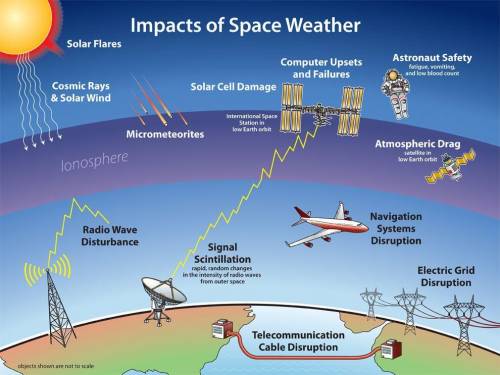
Biology, 23.03.2020 19:15 gggghhhhhhhhhhhh
(100 POINTS)
1. When is the possibility of solar weather affecting terrestrial weather the highest?
A. during Total Solar Irradiance
B. during the solar cycle
C. during solar minimum
D. during solar maximum
2. Which set of terms describes a realistic cause-effect relationship between solar weather and Earth's magnetosphere? Select the two correct.
A. coronal mass ejection -- geomagnetic storm
B. solar wind -- interplanetary magnetic field
C. radiation belt -- aurora
D. geomagnetic storm -- aurora
3. Which do solar flares and coronal mass ejections have in common? Select the two correct responses.
A. They are caused by the sun's changing magnetic field.
B. They appear as dark spots on the sun's surface.
C. They tend to occur during minimum points in the solar cycle.
D. They are explosive events that can affect Earth.
5. What is the irradiance of the sun dependent on?
A. the wavelength of the radiant energy it emits
B. the density of particles in the solar wind
C. the number of sunspots
D. the energetic solar wind particles
6. Select the correct answer from the list.
Based on (temperature, humidity) data and (wind, rainfall) data, scientist think that solar weather has (some, no) effect on terrestrial weather.
7. Which accurately describes solar weather? Choose the two correct answers.
A. Solar flares and sunspots increase as solar minimum approaches.
B. Solar flares and sunspots increase as solar maximum approaches.
C. The intensity of solar weather is constant and unchanging.
D. The intensity of solar weather changes frequently.
8. For a few hours, some satellites experienced electrical failure and at the same time, radio communications at high latitudes were also disrupted. Which is an astronomer most likely to predict was the cause?
A. solar flares
B. solar energetic particles
C. a geomagnetic storm
D. coronal mass ejections
9. Identify the two layers that surround the sun's innermost layer. Select the two correct answers.
A. radiative zone
B. photosphere
C. convection zone
D. chromosphere

Answers: 1


Another question on Biology

Biology, 22.06.2019 00:30
On a recent expedition to a remote region of northern canada, scientists uncovered skeletal remains from about 100,000 years ago. surprisingly, all the skeletal remains, which included many species from differing biological families and spanned about two thousand years, showed evidence of experiencing temperatures in excess of 1000 degrees fahrenheit (or 538 degrees celsius). which of the following, if true, best explains the apparent paradox between the cold environment and the evidence of the bones experiencing hot temperatures? (a) chemical changes that naturally occur during the process of decay in only one north canadian species produce the same evidence of the species' skeletons being exposed to hot temperatures as the expedition scientists found. (b) a little over 103,000 years ago, a large fire is known to have occurred in northern canada. (c) strong evidence exists that as early as 70,000 years ago, homo sapiens around the world relied heavily on fire to cook animals. (d) in the same expedition and in roughly the same layer of excavation, scientists found rudimentary wood cutting and hunting tools used by early humans.
Answers: 3

Biology, 22.06.2019 02:00
The leopard frog and the pickerel frog are two closely related species. in areas where their ranges overlap, the frogs will remain separate species if they
Answers: 2

Biology, 22.06.2019 04:00
Will mark brainliest i only need the ! 1.use ten beads and a centromere of one color to construct the long chromosome. use ten beads and a centromere of a second color to construct the second chromosome in the long pair. make a drawing of the chromosomes in the space below. 2. for the second pair of chromosomes, use only five beads. 3. now model the replication of the chromosomes. make a drawing of your model in the space below. part b: meiosis i during meiosis i, the cell divides into two diploid daughter cells. 4. pair up the chromosomes to form tetrads. use the longer tetrad to model crossing-over. make a drawing of the tetrads in the space below. 5. line up the tetrads across the center of your “cell.” then model what happens to the chromosomes during anaphase i. 6. divide the cell into two daughter cells. use the space below to make a drawing of the result. part c: meiosis ii during meiosis ii, the daughter cells divide again. 7. line up the chromosomes at the center of the first cell, one above the other. separate the chromatids in each chromosome and move them to opposite sides of the cell. 8. repeat step 7 for the second cell. 9. divide each cell into two daughter cells. use the space below to make a drawing of the four haploid cells
Answers: 1

Biology, 22.06.2019 10:00
Rarefaction is used for which of the following? a. creating a representative sample b. studying how disease impacts populations c. rediscovering species thought to be instinct d. determining which sea creatures live in an area
Answers: 1
You know the right answer?
(100 POINTS)
1. When is the possibility of solar weather affecting terrestrial weather t...
1. When is the possibility of solar weather affecting terrestrial weather t...
Questions

Chemistry, 23.01.2021 16:10



Mathematics, 23.01.2021 16:10

Mathematics, 23.01.2021 16:10

Physics, 23.01.2021 16:10

Mathematics, 23.01.2021 16:10

Physics, 23.01.2021 16:10

Computers and Technology, 23.01.2021 16:10


Computers and Technology, 23.01.2021 16:10




Mathematics, 23.01.2021 16:10

Social Studies, 23.01.2021 16:10

Mathematics, 23.01.2021 16:10

Mathematics, 23.01.2021 16:10

Mathematics, 23.01.2021 16:10

Biology, 23.01.2021 16:10




